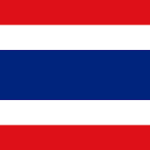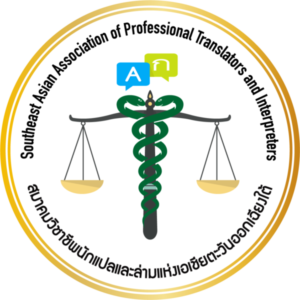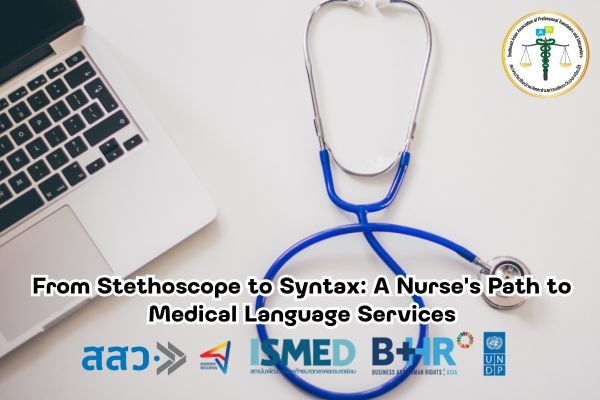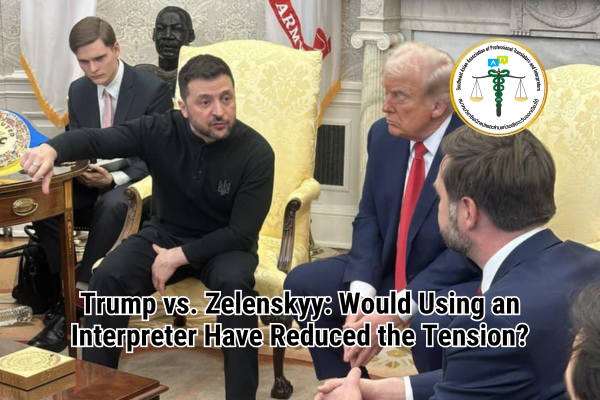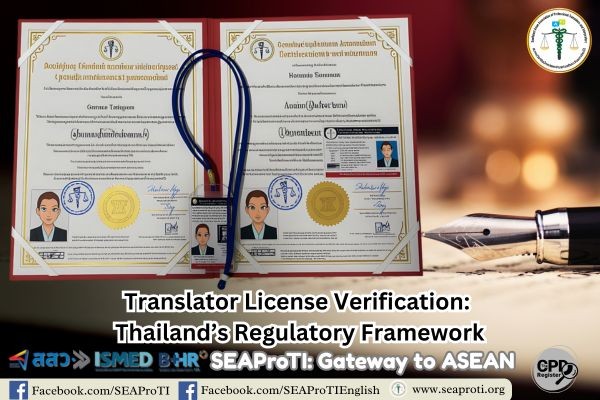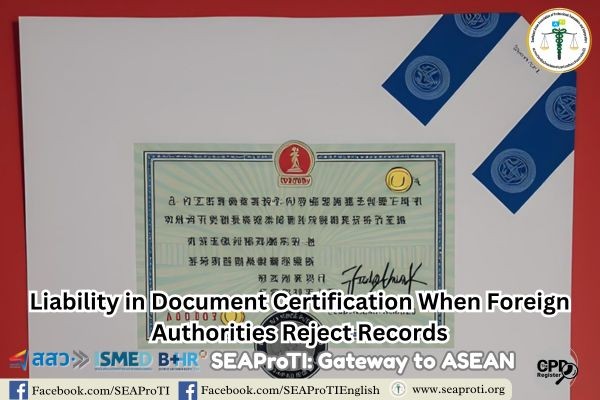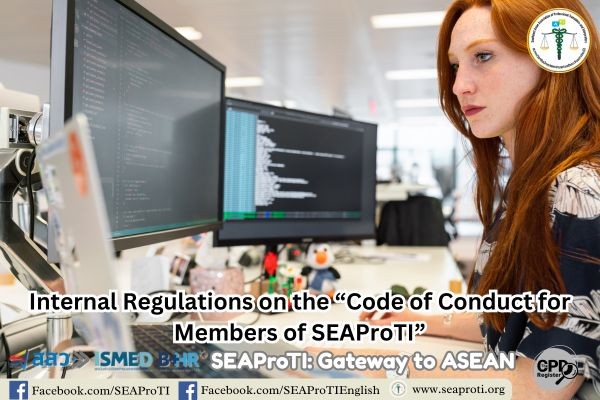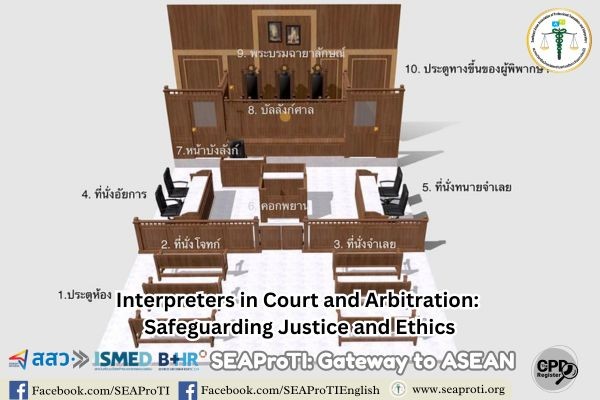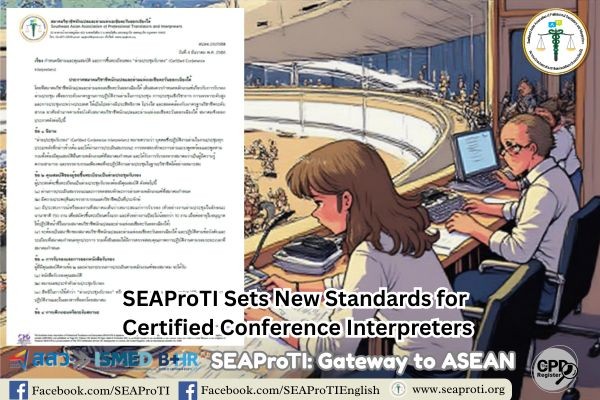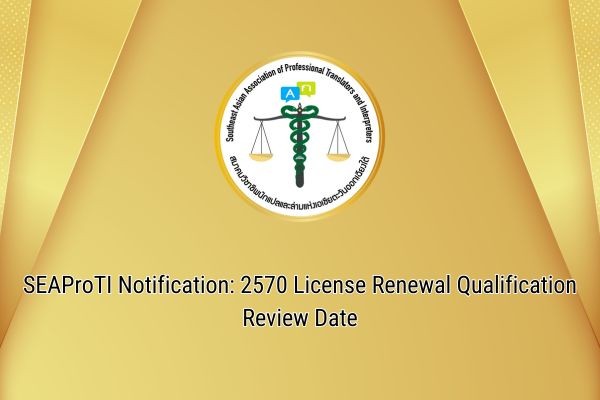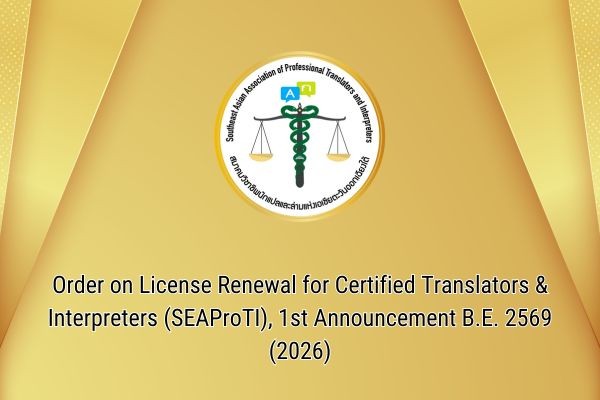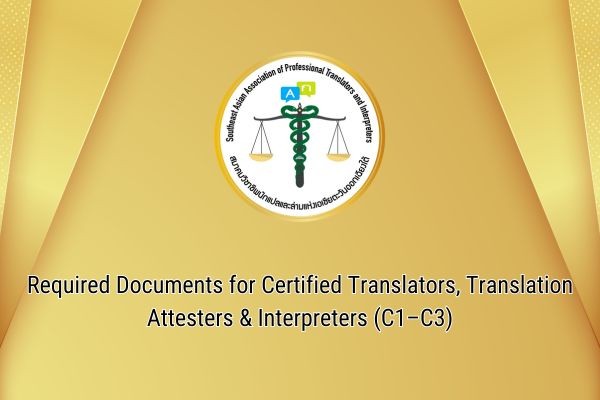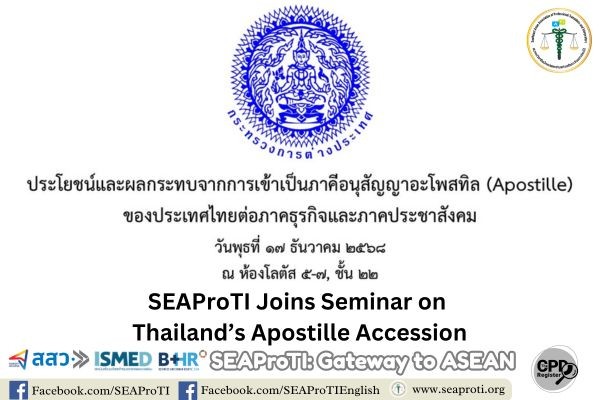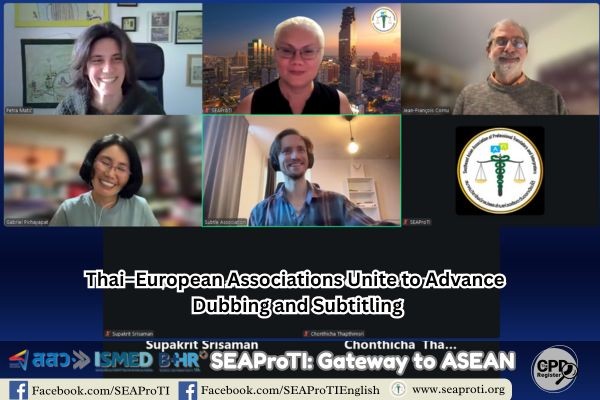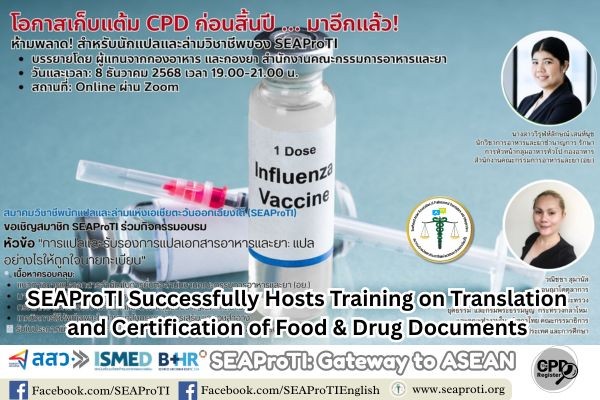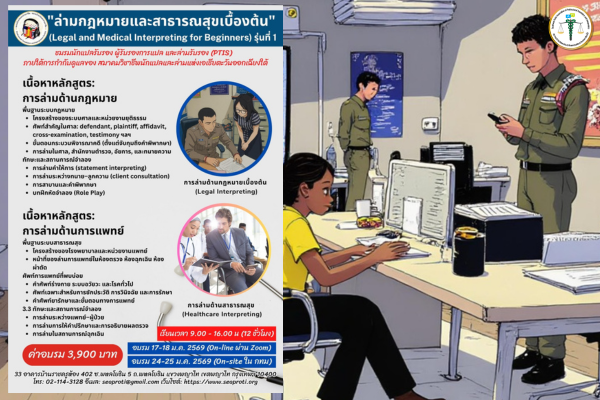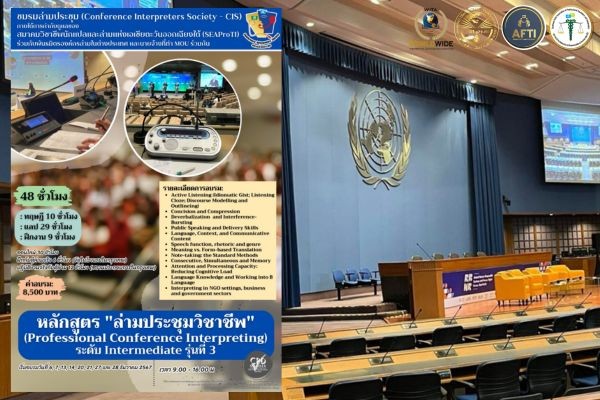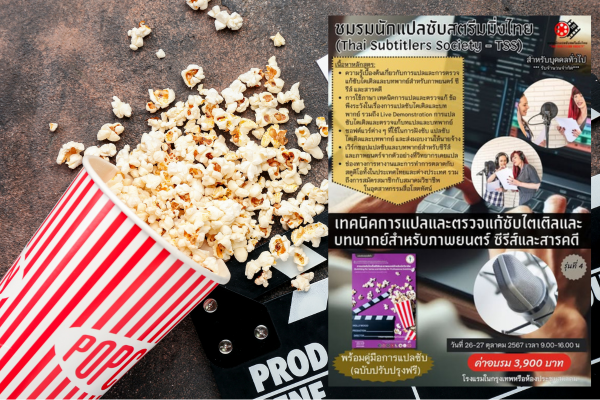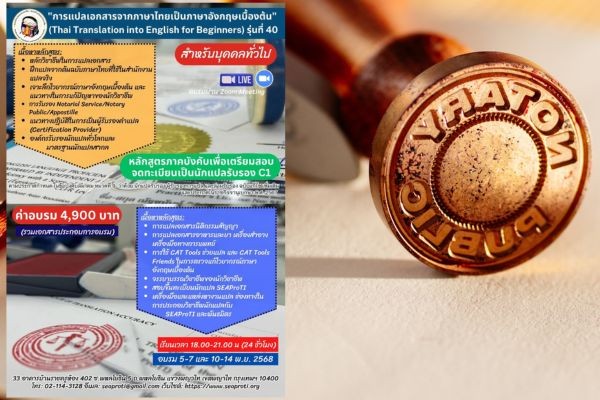A Critical Discourse Analysis of the Translation of the Thai Ministry of Foreign Affairs’
Statement on Anti-Personnel Mines under the Ottawa Convention
Author: Wanitcha Sumanat, President, Southeast Asian Association of Professional Translators and Interpreters (SEAProTI)
11 August 2025, Bangkok – This article analyzes the differences between the original Thai version and the English translation of the Thai Ministry of Foreign Affairs’ statement concerning incidents in July and August 2025, in which Thai soldiers were injured by anti-personnel mines allegedly planted by Cambodian military forces. The study applies the framework of Critical Discourse Analysis (CDA) based on Fairclough (1995) and van Dijk (1998) to examine lexical choices, syntactic structures, discursive strategies, and ideological framing. The findings reveal that the Thai version employs direct accusatory language and emphasizes legitimizing Thailand’s position, while the English version preserves the core content but adjusts the tone for the context of international diplomatic communication.
Introduction
On 16 July 2025, 23 July 2025, and 9 August 2025, a total of 11 Thai soldiers were severely injured by stepping on anti-personnel mines in the Thai–Cambodian border area. The Thai Ministry of Foreign Affairs issued both Thai and English statements in line with the framework of the Anti-Personnel Mine Ban Convention (APMBC) or Ottawa Convention. Comparing the two versions provides valuable insight into state communication in two distinct contexts—domestic and international.
Theoretical Framework and Methodology
This analysis draws on Fairclough’s (1995) three-dimensional CDA model, which examines (1) the textual level, (2) discursive practice, and (3) social practice. It also employs van Dijk’s (1998) Ideological Square to identify the “us–them” emphasis in constructing national images and ideologies.
CDA Findings
Lexical Choices
- Thai version: Employs strongly accusatory terms such as violation of obligations, invasion of sovereignty, serious violation, and rejection of Thailand’s proposal, framing Cambodia as clearly at fault.
- English version: Retains these terms but uses standard diplomatic vocabulary such as violation, gross violation, act of aggression, and introduces softeners like regrettably to maintain formality and reduce confrontational tone.
Syntactic Structure
- Thai: Frequently uses active voice (e.g., “Cambodia carried out…”, “Cambodia rejected…”) to directly identify the actor.
- English: Employs passive voice in several instances (e.g., was recently planted, was identified as), making the content appear more fact-based and reducing direct blame while retaining the original meaning.
Discursive Practice
- Thai: Presents chronological events with legal references, demonstrating that Thailand has “evidence” and is following treaty mechanisms to justify its actions.
- English: Maintains the same structure but adjusts tone and sequencing to fit communication norms in UN and State Party contexts, using diplomatic phrases and softeners.
Ideological Framing (van Dijk’s Ideological Square)
- Emphasize Our Good Actions: Thailand complies with the Convention, notifies States Parties, cooperates with the UN.
- Emphasize Their Bad Actions: Cambodia planted new mines, violated Article 1, rejected joint demining proposals.
- Mitigate Our Bad Actions: No mention of criticisms of Thailand.
- Mitigate Their Good Actions: No mention of Cambodian cooperation or positive actions.
Intended Purposes of the Source and Translation
Purposes of the Thai Original
- Create a diplomatic record showing Thailand as the “wronged” party under international law.
- Use strong language to portray Cambodia as the clear perpetrator.
- Invoke treaty frameworks to enhance legal legitimacy.
- Document events for submission to international forums and inform other States Parties.
Purposes of the English Translation
- Preserve the accuracy of the allegations while adhering to diplomatic protocol.
- Adjust tone to be sufficiently neutral for UN audiences while maintaining the core message.
- Use internationally recognized legal and procedural terminology (e.g., Article 1, compliance mechanism, obliged).
- Avoid language that may appear overly aggressive in multilateral contexts.
Discussion
The key difference between the two versions reflects a discursive strategy adjustment based on audience. The Thai version targets a domestic and regional audience, as well as other States Parties, to show Cambodia’s clear violations. The English version targets the international diplomatic sphere, where communication must remain assertive without being overly aggressive, to avoid jeopardizing actions within the Ottawa Convention framework and broader multilateral relations.
Conclusion
The translation of the Thai Ministry of Foreign Affairs’ statement from Thai into English in this case is not merely a linguistic transfer of meaning, but a discursive re-contextualization aligned with the norms of international diplomatic communication. This study underscores that the translation of state-level diplomatic documents must consider not only semantic accuracy but also tone management to suit the audience’s sociopolitical and institutional context.
References
- Fairclough, N. (1995). Critical discourse analysis: The critical study of language. London: Longman.
- van Dijk, T. A. (1998). Ideology: A multidisciplinary approach. London: SAGE Publications.
- Ministry of Foreign Affairs of Thailand. (2025, August 10). Thailand’s responses under the Anti-Personnel Mine Ban Convention (Ottawa Convention) to the landmine incidents involving Thai military personnel. Retrieved from https://www.mfa.go.th
Appendix
Comparison between the Thai Original and the English Translation
| Aspect | Thai Original | English Translation | Observation |
|---|---|---|---|
| Opening | Begins by stating the dates and events, with details that 11 Thai soldiers were seriously injured by “anti-personnel mines recently planted by Cambodian military forces,” and specifies the exact locations. | Same structure, retaining the numbers, dates, and locations. Uses the phrase “recently planted by Cambodian military personnel.” | Maintains directness, but “recently planted” gives a more factual than accusatory tone. |
| Accusation of Obligation Violation | Uses accusatory expressions such as “violation of Article 1,” “invasion of sovereignty and territorial integrity,” and “serious violation of international law.” | Uses legally precise terms such as “violation of Article 1,” “act of aggression in violation of the sovereignty and territorial integrity,” and “gross violation of international law.” | Preserves severity of wording but shifts to an international diplomatic register. |
| Citing Evidence | States clearly that the mine was identified as “PMN-2 type, which Cambodia possesses.” | “Identified as a PMN-2 type, which is in Cambodia’s possession.” | Direct translation, but English uses passive construction to convey a more neutral tone. |
| Linking to GBC Meeting Context | Highlights that the mine-laying occurred two days after the meeting and links it to Cambodia’s rejection of Thailand’s proposal. | Retains full details in English but uses “Regrettably,” a marker of diplomatic hedging. | Adds international-style politeness while still maintaining blame. |
| Legal Reference (Article 8, para. 2) | Explains the “request for clarification” process through the UN Secretary-General and Cambodia’s obligations. | Fully translates the legal procedure, using terms like “compliance mechanism” and “obliged to provide information.” | Emphasizes the treaty-based process rather than direct accusation. |
| Convention Background Information | Specifies the years in which Thailand and Cambodia joined, and confirms completion of mine destruction. | Retains the content but places it in a concluding summary paragraph. | Reduces repetition, making it read more like a briefing. |
การวิเคราะห์เชิงวาทกรรมวิพากษ์ของการแปลประกาศกระทรวงการต่างประเทศไทยต่อกรณีทุ่นระเบิดสังหารบุคคลภายใต้อนุสัญญาออตตาวา
ผู้เขียน วณิชชา สุมานัส นายกสมาคมวิชาชีพนักแปลและล่ามแห่งเอเชียตะวันออกเฉียงใต้ (SEAProTI)
บทความนี้วิเคราะห์ความแตกต่างระหว่างต้นฉบับภาษาไทยและฉบับแปลภาษาอังกฤษของถ้อยแถลงกระทรวงการต่างประเทศไทยว่าด้วยเหตุการณ์ทหารไทยเหยียบทุ่นระเบิดสังหารบุคคลซึ่งถูกกล่าวหาว่าวางโดยกองกำลังทหารกัมพูชาในเดือนกรกฎาคมและสิงหาคม 2568 โดยใช้กรอบการวิเคราะห์เชิงวาทกรรมวิพากษ์ (Critical Discourse Analysis: CDA) ตามแนวคิดของ Fairclough (1995) และ van Dijk (1998) เพื่อศึกษาการเลือกใช้ถ้อยคำ โครงสร้างประโยค กลยุทธ์เชิงวาทกรรม และการสร้างภาพทางอุดมการณ์ ผลการวิเคราะห์พบว่าต้นฉบับภาษาไทยมีลักษณะการกล่าวหาเชิงตรงและเน้นการสร้างความชอบธรรมของฝ่ายไทย ขณะที่ฉบับแปลภาษาอังกฤษยังคงเนื้อหาหลักแต่ปรับโทนให้เหมาะกับเวทีการทูตระหว่างประเทศ
บทนำ
เมื่อวันที่ 16 กรกฎาคม 2568, 23 กรกฎาคม 2568 และ 9 สิงหาคม 2568 เกิดเหตุทหารไทยรวม 11 นายได้รับบาดเจ็บสาหัสจากการเหยียบทุ่นระเบิดสังหารบุคคลในพื้นที่ชายแดนไทย–กัมพูชา กระทรวงการต่างประเทศได้ออกถ้อยแถลงภาษาไทยและภาษาอังกฤษเพื่อดำเนินการตามกรอบอนุสัญญาห้ามทุ่นระเบิดสังหารบุคคล (Anti-Personnel Mine Ban Convention: APMBC) หรืออนุสัญญาออตตาวา (Ottawa Convention) การเปรียบเทียบทั้งสองเวอร์ชันมีคุณค่าต่อการทำความเข้าใจการสื่อสารของรัฐในสองบริบท ภายในประเทศและในเวทีสากล
กรอบแนวคิดและระเบียบวิธี
การวิเคราะห์นี้อิงกรอบ CDA ของ Fairclough (1995) ซึ่งพิจารณา 3 มิติ ได้แก่ (1) ข้อความ (text) (2) การปฏิบัติทางวาทกรรม (discursive practice) และ (3) การปฏิบัติทางสังคม (social practice) พร้อมใช้ Ideological Square ของ van Dijk (1998) เพื่อดูการเน้น “เรา–เขา” ในการสร้างภาพลักษณ์และอุดมการณ์
การวิเคราะห์ด้วย Critical Discourse Analysis (CDA)
ผมใช้กรอบ Fairclough (1995) และ van Dijk’s Ideological Square เพื่อวิเคราะห์
ระดับคำ (Lexical choices)
- ภาษาไทย ใช้คำเชิงกล่าวหา (accusatory terms) เช่น ละเมิดพันธกรณี, รุกรานอธิปไตย, ละเมิดอย่างร้ายแรง, ปฏิเสธข้อเสนอไทย → framing ให้กัมพูชาเป็นผู้ผิดอย่างชัดเจน
- ภาษาอังกฤษ คงคำเหล่านี้ แต่เลือกคำที่เป็นมาตรฐานการทูต เช่น violation, gross violation, act of aggression, และเพิ่มคำเชื่อมอย่าง regrettably เพื่อคงน้ำเสียงทางการและลดความ confrontational
ระดับโครงสร้างประโยค (Syntactic structure)
- ภาษาไทย ใช้ active voice บ่อย เช่น “กัมพูชาได้กระทำการ…”, “กัมพูชาปฏิเสธ…” → เน้นตัวผู้กระทำ
- ภาษาอังกฤษ ใช้ passive voice บางส่วน เช่น was recently planted, was identified as → ทำให้เนื้อหาดู fact-based และลด direct blame แต่ยังคงความหมายเดิม
ระดับวาทกรรม (Discourse practice)
- ภาษาไทย จัดลำดับเหตุการณ์ + อ้างกฎหมาย → แสดงให้เห็นว่าไทยมี “หลักฐาน” และใช้ช่องทางตามสนธิสัญญาเพื่อสร้างความชอบธรรม
- ภาษาอังกฤษ รักษาโครงสร้างเดียวกัน แต่ปรับโทนให้เหมาะกับการสื่อสารในเวทีระหว่างประเทศ เช่น ใช้คำเชื่อม softeners และ diplomatic phrases
อุดมการณ์ (Ideological framing)
ใช้ Ideological Square:
- Emphasize Our Good Actions: ไทยดำเนินการตามกรอบอนุสัญญา, แจ้งรัฐภาคี, ทำงานกับ UN
- Emphasize Their Bad Actions: กัมพูชาวางทุ่นใหม่, ละเมิดข้อ 1, ปฏิเสธข้อเสนอร่วมเก็บกู้
- Mitigate Our Bad Actions: ไม่มีการกล่าวถึงข้อครหาใด ๆ ฝ่ายไทย
- Mitigate Their Good Actions: ไม่มีการพูดถึงความร่วมมือหรือท่าทีบวกของกัมพูชา
สิ่งที่ผู้เขียนต้นฉบับไทยและผู้แปลต้องการ
- ผู้เขียนต้นฉบับไทยต้องการ
- สร้างบันทึกทางการทูต ที่แสดงว่าไทยถูกละเมิดและเป็น “ฝ่ายถูก” ในกรอบกฎหมายระหว่างประเทศ
- ใช้ถ้อยคำแข็งแรง เพื่อสร้างภาพว่ากัมพูชาเป็นผู้กระทำผิดชัดเจน
- อ้างกรอบกฎหมาย เพื่อเพิ่มน้ำหนักทางความชอบธรรม
- บันทึกเหตุการณ์เพื่อการยื่นต่อเวทีระหว่างประเทศ และให้รัฐภาคีอื่นทราบ
- ผู้แปลต้องการ
- รักษาความถูกต้องของข้อกล่าวหา แต่ใช้ภาษาในเชิง diplomatic protocol
- ปรับน้ำเสียง ให้เป็นกลางพอที่จะอ่านในเวทีสหประชาชาติ แต่ยังคงสารหลัก
- ใช้โครงสร้างและศัพท์กฎหมายสากล เช่น Article 1, compliance mechanism, obliged
- หลีกเลี่ยงการใช้ภาษาที่อาจดู aggressive เกินไป ในบริบทการสื่อสารกับนานาชาติ
อภิปรายผล
ความแตกต่างสำคัญระหว่างสองเวอร์ชันสะท้อนถึง การปรับกลยุทธ์ทางวาทกรรมตามผู้รับสาร—ภาษาไทยมุ่งให้คนในประเทศและรัฐภาคีรับรู้ว่ากัมพูชาเป็นฝ่ายละเมิดอย่างชัดเจน ขณะที่ภาษาอังกฤษมุ่งสื่อสารในกรอบการทูตสากลที่ต้องคงความ assertive แต่ไม่ aggressive เกินไป เพื่อไม่ให้กระทบต่อการดำเนินการในกรอบอนุสัญญาและความสัมพันธ์พหุภาคี
บทสรุป
การแปลถ้อยแถลงของกระทรวงการต่างประเทศจากภาษาไทยเป็นภาษาอังกฤษในกรณีนี้มิใช่เพียงการถอดรหัสความหมายเชิงภาษา แต่ยังเป็นการ ปรับเชิงวาทกรรม (discursive re-contextualization) เพื่อให้สอดคล้องกับบรรทัดฐานของการสื่อสารทางการทูตระหว่างประเทศ การศึกษาเช่นนี้ชี้ให้เห็นว่าการแปลเอกสารรัฐทูตต้องคำนึงถึงทั้งความถูกต้องทางเนื้อหาและการจัดวางน้ำเสียงให้เหมาะสมกับบริบทของผู้รับสาร
ภาคผนวก
การเปรียบเทียบต้นฉบับไทย – ฉบับแปลอังกฤษ
| ประเด็น | ต้นฉบับไทย | ฉบับแปลอังกฤษ | สังเกต |
|---|---|---|---|
| การเปิดเรื่อง | เริ่มด้วยการระบุวันที่และเหตุการณ์ พร้อมรายละเอียดว่าทหารไทย 11 นายได้รับบาดเจ็บสาหัสจาก “ทุ่นระเบิดสังหารบุคคลที่วางใหม่โดยกองกำลังทหารกัมพูชา” และระบุพื้นที่อย่างละเอียด | โครงสร้างเหมือนกัน เก็บตัวเลข วันที่ และสถานที่ครบ ใช้คำว่า “recently planted by Cambodian military personnel” | รักษาความตรงไปตรงมา แต่คำว่า “recently planted” ทำให้โทนดู factual มากกว่า accusatory |
| การกล่าวหาการละเมิดพันธกรณี | ใช้ถ้อยคำเชิงกล่าวหา เช่น “ละเมิดพันธกรณีข้อ 1” “การรุกรานอธิปไตยและบูรณภาพแห่งดินแดน” “ละเมิดกฎหมายระหว่างประเทศอย่างร้ายแรง” | ใช้คำที่ตรงกับข้อกฎหมาย เช่น “violation of Article 1” “act of aggression in violation of the sovereignty and territorial integrity” “gross violation of international law” | รักษาความรุนแรงของถ้อยคำ แต่ปรับให้อยู่ใน register ทางการทูตสากล |
| การอ้างหลักฐาน | ระบุชัดว่าพบว่าเป็น “ทุ่นระเบิดชนิด PMN-2 ซึ่งกัมพูชาครอบครอง” | “identified as a PMN-2 type, which is in Cambodia’s possession” | ถอดความตรง แต่อังกฤษใช้โครงสร้าง passive เพื่อให้โทนเป็นกลาง |
| การเชื่อมโยงบริบทการประชุม GBC | ชี้ให้เห็นว่าการวางทุ่นเกิด 2 วันหลังประชุม และเชื่อมกับการปฏิเสธข้อเสนอไทย | อังกฤษเก็บรายละเอียดครบ แต่ใช้ “Regrettably” ซึ่งเป็นเครื่องหมายของ diplomatic hedging | เพิ่มความสุภาพแบบสากลแต่ยังคง blame |
| การอ้างอิงข้อกฎหมาย (ข้อ 8 วรรค 2) | อธิบายกระบวนการ “ขอรับความชัดเจน” (request for clarification) ผ่านเลขาธิการ UN และภาระของกัมพูชา | แปลตามโครงสร้างกฎหมายครบถ้วน ใช้คำว่า “compliance mechanism” “obliged to provide information” | เน้นความเป็นกระบวนการตามสนธิสัญญา มากกว่าเน้นการตำหนิ |
| ข้อมูลพื้นหลังอนุสัญญา | ระบุปีเข้าร่วมของไทยและกัมพูชา และการทำลายทุ่นระเบิดครบถ้วน | เก็บเนื้อหาครบ แต่จัดเป็นย่อหน้าสรุปท้าย | ตัดความซ้ำซ้อน ทำให้อ่านแบบ briefing |
เอกสารอ้างอิง
- Fairclough, N. (1995). Critical discourse analysis: The critical study of language. London: Longman.
- van Dijk, T. A. (1998). Ideology: A multidisciplinary approach. London: SAGE Publications.
- Ministry of Foreign Affairs of Thailand. (2025, August 10). Thailand’s Responses under the Anti-Personnel Mine Ban Convention (Ottawa Convention) to the Landmine Incidents involving Thai Military Personnel. Retrieved from https://www.mfa.go.th
เกี่ยวกับนักแปลรับรอง ผู้รับรองการแปล และล่ามรับรองของสมาคมวิชาชีพนักแปลและล่ามแห่งเอเชียตะวันออกเฉียงใต้
สมาคมวิชาชีพนักแปลและล่ามแห่งเอเชียตะวันออกเฉียงใต้ (SEAProTI) ได้ประกาศหลักเกณฑ์และคุณสมบัติผู้ที่ขึ้นทะเบียนเป็น “นักแปลรับรอง (Certified Translators) และผู้รับรองการแปล (Translation Certification Providers) และล่ามรับรอง (Certified Interpreters)” ของสมาคม หมวดที่ 9 และหมวดที่ 10 ในราชกิจจานุเบกษา ของสำนักเลขาธิการคณะรัฐมนตรี ในสำนักนายกรัฐมนตรี แห่งราชอาณาจักรไทย ลงวันที่ 25 ก.ค. 2567 เล่มที่ 141 ตอนที่ 66 ง หน้า 100 อ่านฉบับเต็มได้ที่: นักแปลรับรอง ผู้รับรองการแปล และล่ามรับรอง
